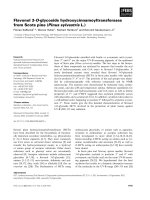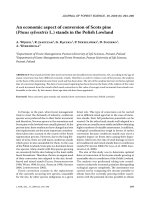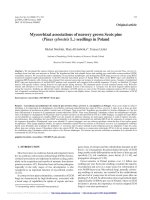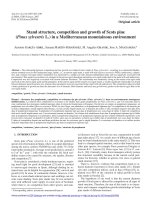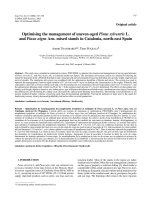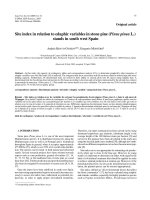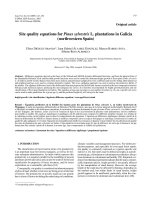Adaptive genetic variation in scots pine (pinus sylvestris l ) in scotland
Bạn đang xem bản rút gọn của tài liệu. Xem và tải ngay bản đầy đủ của tài liệu tại đây (2.45 MB, 170 trang )
Adaptive genetic variation in Scots pine (Pinus
sylvestris L.) in Scotland
Matti J. Salmela
PhD
The University of Edinburgh
2011
Declaration
I hereby declare that this thesis is composed of work carried out by myself unless
otherwise acknowledged and that it has not in whole or in part been previously
presented for any other degree or professional qualification.
Matti Salmela
Oulu, Finland, January 2011
i
Acknowledgements
This project was carried out at CEH Edinburgh and funded by Scottish Forestry
Trust. I would like to thank my supervisors Stephen Cavers, Joan Cottrell, Glenn
Iason, and Richard Ennos for kicking off this project and for all the guidance and
support in the course of my PhD. Having multiple supervisors can be a challenge
(I've heard plenty of horror stories - not about you!), but I must have gotten lucky.
Thank you for being a very harmonious group and for not trying to pull me to
different directions (it wouldn't have worked anyway). I hope work on adaptation in
native Scots pine (and maybe also in other trees in Scotland) will continue well into
the future.
Many other people have contributed to this work, directly or indirectly. I thank the
seed collectors Dave Sim, Joan Beaton, and Ben Moore at Macaulay Institute in
Aberdeen and Anandan Govindarajulu and Alysha Sime for assistance in data
collection and trial maintenance. During these three years I've had countless more or
less science-related discussions with fellow Bush genetics or botany people Witold
Wachowiak, Tytti Vanhala, Julia Wilson, Annika Telford, and David Odee. Thanks
for listening! Oli todella mukava yllätys, että naapurista löytyi toinen Oulun
geneetikko, jonka kanssa sai keskustella genetiikasta ja kaikesta muustakin ihan
suomeksi - ja Oulun murteella (taisi tosin useimmiten olla finglishiä se meidän kieli).
Erikoiskiitokset Tytille & DJ:lle monista kivoista patikointiretkistä ja siitä, että sain
käydä kolmesti perinteisessä suomalaisessa saunassa Skotlannin-vuosieni aikana! At
CEH and Forest Research, I thank Frank Harvey, Lucy Sheppard, Beth Purse, Katie
Bates, Stuart A‟Hara, Mike Perks, and Duncan Ray for helping me with various bits
and pieces during my PhD. Joanne Russell from SCRI and Rosario García-Gil from
Umeå Plant Science Centre are acknowledged for sharing their microsatellite data
and experiences.
A massive thank you to my fellow PhD students and friends at CEH with whom I've
had the pleasure of sharing an office. I hope you have enjoyed hearing „moderate‟
Finnish views on everything, even if you didn‟t ask for them (now that I think about
ii
it, you probably never did). I'm missing our regular and therapeutic pub nights
already, partly because I have to pay a lot more for my pints here in Finland. Emily
Barlow, James Ryder, Sanna Kivimäki, and Lorna Wilkie must be specifically
mentioned since they've had to put up with me most. I enjoyed being in the 'Room of
Doom' with you guys!
Lopuksi suuret kiitokset kannustuksesta ja sponsoroinnista kotiväelle Ouluun, tässä
taas hyllyntäytettä olohuoneeseen, vaihteeksi eri kielellä tosin. Karhun perheelle
myös kiitos teknisestä avustuksesta tässä loppumetreillä.
Toivottavasti ei aivan päin mäntyä mennyt tämäkään urakka.
”Pitkäaikainen käyttö ja yliannokset voivat
aiheuttaa painostavan olon ja verenpaineen
laskua.”
- mäntyperäisten luontaisrohtojen käyttöön liittyviä riskejä
iii
Abstract
Genetic differentiation in phenotypic traits among populations from heterogeneous
environments is often observed in common-garden studies on forest trees, but data on
adaptive variation in Scots pine (Pinus sylvestris L.) in Scotland are limited. As a
result, current seed transfer guidelines are based on earlier molecular marker studies
and do not take into account environmental or adaptive genetic variation. An analysis
of spatial variation in climate showed substantial differences in temperature and
precipitation among the native Scots pine sites in Scotland. To investigate whether
differentiation in response to environmental variation has occurred in Scotland, a
glasshouse-based common-garden trial of ~3,360 seedlings from 21 populations and
84 open-pollinated families was established in 2007. At the beginning of the 2nd
growing season, timing of bud flush showed evidence of genetic differentiation
among populations, with those from cooler origins generally flushing earlier.
Variation was also found among families within populations, suggesting that the trait
is genetically controlled. Populations and families showed different levels of
variability in this trait which could be partly due to variable levels of temporal
climate fluctuation in different parts of Scotland. Chlorophyll fluorescence was used
to examine drought response in three-year old seedlings from five populations on
sites that experience contrasting levels of annual rainfall. It was found that the
response was not related to rainfall, but possibly to more complex moisture variables
that also take into account additional factors such as evaporation. Also,
photosynthetic capacity in response to cold winter temperatures varied significantly
among eight populations that were kept outdoors, and the largest reduction was seen
in seedlings from the mildest, most maritime coastal site. The following spring,
height growth and needle flush started earlier in seedlings from cooler locations.
Earlier studies on genetic diversity of native pinewoods have shown high levels of
selectively neutral variation in this predominantly outcrossing conifer, and a mating
system analysis with a limited number of microsatellite markers supported this
pattern. Together, these data suggest that despite significant historic population size
decrease, environmental gradients have resulted in genetic differentiation among
native pinewoods. In order to minimise the risk of planting poorly-adapted stock and
iv
to maximise the success of replanting programmes, it is important that the origins of
planting stock are carefully considered in management guidelines for the species.
v
Contents
1.
Introduction ................................................................................................. 1
1.1 Basics of local adaptation...................................................................................... 1
1.1.1 What is local adaptation? .................................................................................................... 1
1.1.2 Local adaptation in plants .................................................................................................... 2
1.1.3 Local adaptation in trees ..................................................................................................... 5
1.2 Case study: adaptation in Scots pine in Scotland.................................................. 14
1.2.1 Evolutionary history of Scots pine in Scotland .................................................................. 15
1.2.2 Current state of native pinewoods .................................................................................... 17
1.2.3 Management of genetic resources in Scots pine ............................................................... 18
1.2.4 Environmental variation within Scotland .......................................................................... 19
1.2.5 Current knowledge about genetic variation in Scottish pinewoods .................................. 23
1.2.6 Maintenance of adaptive potential in native pinewoods .................................................. 24
1.2.7 Combining quantitative trait and molecular marker data ................................................. 26
1.3 The objectives of this thesis ................................................................................ 28
2.
Mating system in Scots pine (Pinus sylvestris L.) in Scotland ........................ 30
2.1 Introduction ....................................................................................................... 30
2.2 Materials and methods ....................................................................................... 32
2.2.1 DNA extraction .................................................................................................................. 32
2.2.2 Polymerase-chain reaction (PCR) ...................................................................................... 32
2.2.3 Agarose electrophoresis .................................................................................................... 34
2.2.4 Genotyping ........................................................................................................................ 34
2.2.5 Mating system analysis ...................................................................................................... 34
2.2.6 Growth characters ............................................................................................................. 35
2.3 Results ............................................................................................................... 35
2.3.1 Microsatellite amplification ............................................................................................... 35
2.3.2 Mating system analysis ...................................................................................................... 35
2.4 Discussion .......................................................................................................... 38
2.4.1 Microsatellite amplification ............................................................................................... 39
2.4.2 Variation in mating system ................................................................................................ 39
2.5 Conclusions ........................................................................................................ 43
3.
Variation in timing of bud flush among native pinewoods in Scotland ......... 45
3.1 Introduction ....................................................................................................... 45
3.2 Materials and methods ....................................................................................... 48
3.2.1 Study populations .............................................................................................................. 48
3.2.2 Climate data ....................................................................................................................... 49
3.2.3 Common-garden trials ....................................................................................................... 50
3.2.4 Statistical analyses ............................................................................................................. 52
3.3 Results ............................................................................................................... 54
3.3.1 Spatial climate variation .................................................................................................... 54
3.3.2 Temporal climate variation ................................................................................................ 54
3.3.3 Timing of bud flush ............................................................................................................ 55
3.4 Discussion .......................................................................................................... 61
vi
3.4.1 Spatial and temporal climate variability ............................................................................ 61
3.4.2 Variation in timing of bud flush ......................................................................................... 64
3.4.3 Within-population variation in timing of bud flush ........................................................... 66
3.4.4 Temporally fluctuating environment and adaptive genetic diversity ................................ 71
3.4.5 Effects of environmental fluctuations on reproduction .................................................... 72
3.4.6 Effects of temporal fluctuations on genetic structures ..................................................... 73
3.4.7 Differences between 2008 and 2009 ................................................................................. 74
3.5 Conclusions ........................................................................................................ 75
4. Fast phenotyping using chlorophyll fluorescence detects drought response in
a common-garden trial of five native Scots pine (Pinus sylvestris L.) populations in
Scotland ............................................................................................................ 78
4.1 Abstract ............................................................................................................. 78
4.2 Introduction ....................................................................................................... 79
4.3 Materials and Methods....................................................................................... 82
4.3.1 Study populations .............................................................................................................. 82
4.3.2 Sampling ............................................................................................................................ 83
4.3.3 Drought stress.................................................................................................................... 85
4.3.4 Analysis .............................................................................................................................. 87
4.4 Results ............................................................................................................... 88
4.4.1 Water deficit (WD) ............................................................................................................. 88
4.4.2 Chlorophyll fluorescence ................................................................................................... 90
4.4.3 Proportion of fully brown seedlings (mortality) ................................................................ 94
4.5 Discussion .......................................................................................................... 96
4.5.1 Response to drought ......................................................................................................... 97
4.5.2 Variation among populations and families ........................................................................ 98
4.5.3 Summary .......................................................................................................................... 101
4.6 Acknowledgements ...........................................................................................102
5. Seasonal patterns of photochemical capacity and spring phenology reveal
genetic differentiation among eight native Scots pine (Pinus sylvestris L.)
populations in Scotland ....................................................................................103
5.1. Abstract ...........................................................................................................103
5.2 Introduction ......................................................................................................104
5.3 Materials and methods ......................................................................................108
5.3.1 Study populations ............................................................................................................ 108
5.3.2 Experimental setting ........................................................................................................ 109
5.3.3 Chlorophyll fluorescence ................................................................................................. 111
5.3.4 Spring phenology ............................................................................................................. 112
5.3.5 Statistical analyses ........................................................................................................... 112
5.4 Results ..............................................................................................................113
5.4.1 Temperature variation at the experimental site ............................................................. 113
5.4.2 Photochemical capacity (Fv/Fm) ....................................................................................... 114
5.4.3 Variation in mean overall Fm and F0 ................................................................................. 115
5.4.4 Associations with environmental variables ..................................................................... 115
5.4.5 Spring phenology ............................................................................................................. 118
5.6 Discussion .........................................................................................................121
vii
5.6.1 Seasonal variation in photochemical capacity ................................................................. 121
5.6.2 Variation among populations .......................................................................................... 123
5.6.3 Spring phenology ............................................................................................................. 125
5.7 Acknowledgments .............................................................................................128
6. Conclusions ...................................................................................................129
6.1 Climate variation in Scotland .............................................................................130
6.2 Adaptive differences among Scots pine populations ...........................................131
6.2.1 Spring phenology ............................................................................................................. 131
6.2.2 Response to droughting and winter/spring temperatures .............................................. 131
6.2.3 Effects of the environment on quantitative trait expression .......................................... 133
6.2.4 What is local adaptation in temporally unstable environments? .................................... 134
6.3 Future research recommendations .....................................................................136
6.4 Practical implications for pinewood management ..............................................138
7. References ....................................................................................................143
8. Supplementary material................................................................................159
viii
List of figures
Figure 1.1 Distribution of Scots pine in Europe (source: ). .......................... 14
Figure 1.2 Map of the current Scots pine seed zones in Scotland. ....................................................... 21
Figure 1.3 Plot of the two principal components (PC), which account for 69 and 24% of total
variation, respectively, of climatic variation among 84 native pinewood sites. The seven variables
used are shown in table 1.1. Current seed zones are represented by different symbols, and the closer
the populations are in the graph, the more similar they are climatically. PC1 represents a gradient in
annual rainfall and temperature: populations with more negative values are generally located in the
west (high rainfall, mild climate); positive values represent more eastern pinewoods with less rainfall
and colder winters. ............................................................................................................................... 21
Figure 2.1 Population estimates of tm. Error bars mark 95% confidence intervals. ............................. 37
Figure 2.2 Population estimates of rp. Error bars mark 95% confidence intervals. .............................. 37
Figure 2.3 Population estimates of tm-ts. Error bars mark 95% confidence intervals. .......................... 38
Figure 3.1 Map of the sampled populations, grouped according to their seed zones. Climatic features
of the sites are shown in table 3.1........................................................................................................ 48
Figure 3.2 a) Temporal variation in mean annual GSL and GDD; b) temporal variation in annual FTs
and February NAO indices; c) relationship between the altitudes of the 21 native pinewood sites and
variability of winter and summer temperatures, expressed as the average of MADs of FT and JT; d)
CVs of temporal variation in GSL and GDD plotted against site altitude. The climate data used cover
the period 1960-2000. In a) and b), annual means were calculated over the 5 × 5 km grids within
which the 21 pinewood sites are located. ............................................................................................ 56
Figure 3.3 Relationship between site altitude and CVs in timing of bud flush in 2008 among 21
2
populations in the two trials. In the Edinburgh trial: β0=44.33, β1=0.0524, p<0.001, R =44%; in the
2
Aberdeen trial: β0=24.69, β1=0.0498, p<0.001, R =46.1%. ................................................................... 60
Figure 4.1 Locations of the sampled populations. ............................................................................... 84
Figure 4.2 Interaction plot of population means of WD on June 29. ................................................... 89
Figure 4.3 Control and drought treatment means and standard deviations of F v/Fm between June 9-10
and June 30-July 1. ............................................................................................................................... 94
Figure 4.4 Control and drought treatment means and standard deviations of PI ABS on June 23-24 and
June 30-July 1. ...................................................................................................................................... 95
Figure 4.5 Relationship between WD on June 29 and efficiency of PSII within the drought treatment
on June 23-24 (r=-0.56, p<0.0001). Efficiency of PSII=Fv/Fm/(1-(Fv/Fm)), and water deficit=WD/(1-WD).
.............................................................................................................................................................. 95
Figure 4.6 Relationship between site MD and family means of efficiency of PSII on June 23-24
2
(β0=0.411, β1=0.017, p=0.0007, R =0.46). Efficiency of PSII=Fv/Fm/(1-(Fv/Fm)). .................................... 96
Figure 5.1 Locations of the sampled populations and the study site (CEH Edinburgh). ..................... 108
Figure 5.2 Average daily temperatures at the experimental site between September 17 2009 and June
15 2010 and variation in population means of Fv/Fm between September 17 2009 and May 9 2010.
The dates on which significant differences among populations were found are marked with star
symbols............................................................................................................................................... 116
Figure 5.3 Variation in overall means of F0 and Fm between September 17 2009 and May 9 2010. . 117
Figure 5.4 Relationship between altitude at home location and family means of efficiency of PSII
2
(Fv/Fm/(1-Fv/Fm)) on January 22 (β0=0.970, β1=0.0015, p<0.001, R =37%). ........................................ 119
Figure 5.5 Relationship between altitude at home location and family means of efficiency of PSII
2
2
(Fv/Fm/(1-Fv/Fm)) on March 21 (β0=1.110, β1 =0.00341, β =-0.0000056, p=0.022, R =18%). ............. 120
Figure 5.6 Relationship between altitude at home location and family means of needle flush
2
(β0=214.72, β1=-0.067, p<0.05, R =13%). ........................................................................................... 120
ix
List of tables
Table 1.1 List of climatic variables used in the principal component (PC) analysis. Values in the table
are correlation coefficients that vary between -1 (strong negative correlation) and 1 (strong positive
correlation); the further the coefficient is from zero, the stronger the association between the
variable and the PC. PC1 is the main component, explaining 69% of the variation. ............................ 22
Table 1.2 Range of climatic variation in four variables within each seed zone according to the UK Met
Office long-term average data (Perry and Hollis 2005). Seed zones: EC=East Central, N=North,
NC=North Central, NE=North East, NW=North West, SC=South Central, SW=South West. Climatic
variables: LGS=length of the growing season, FMT=February mean temperature, JMT=July mean
temperature, AP=annual precipitation................................................................................................. 22
Table 2.1 PCR reagent mix protocols (per one sample) used for the five primers. .............................. 33
Table 2.2 PCR programme protocols used for a) SPAG7.14, b) PtTX4001 and PtTX4011, and c)
SPAC11.8 and PtTX3107. ...................................................................................................................... 33
Table 3.1 Populations included in the study, their coordinates (Lat., latitude; Long., longitude), mean
altitude of the sampled sites within populations (Alt.), and average (1961-1990 or 1961-2000) climate
features: growing season length (GSL; days), growing degree days (GDD: day degrees), February and
July mean temperatures (FMT and JMT), and annual precipitation (AP). ............................................ 49
Table 3.2 ANOVA results for timing of bud flush in the Edinburgh in a) 2008 and b) 2009, c) in the
Aberdeen trial in 2008, and d) ANCOVA for the 2008 data. ................................................................. 57
Table 4.1 Environmental data for populations and sites included in the drought study. Columns are
pinewood size (PS) according to Mason, Hampson et al. (2004), growing season length (GSL), annual
precipitation (AP), family (site) name, altitude, aspect (AS), accumulated temperature (AT), moisture
deficit (MD), peat depth (PD), and average height of the seedlings in the family (AH). ...................... 84
Table 4.2 ANOVA tables with mean squares for WD on a) June 9 and b) 29. ns=P>0.05; *=P<0.05;
**=P<0.01, ***=P<0.001. ..................................................................................................................... 89
Table 4.3 Population means and standard deviations of Fv/Fm on June 9-10, June 23-24, and June 30July 1, and of PIABS on June 23-24 and June 30-July 1. .......................................................................... 92
Table 4.4 ANOVA tables with mean squares for Fv/Fm and PIABS on June a) 9-10, b) 23-24, and c) June
30-July 1. ns=P>0.05; *=P<0.05; **=P<0.01, ***=P<0.001. ................................................................. 93
Table 5.1 Environmental data for populations and sites included in the study. Columns are core
pinewood size (CPS; ha) according to Mason, Hampson et al. (2004), growing season length (GSL;
days), air and ground frost days per year (FD A, G; days), mean February (MFT; °C) and July
temperatures (MJT; °C), family (site) name, altitude (AL; m), aspect (AS), and accumulated
temperature (AT, day degrees). ......................................................................................................... 110
Table 5.2 ANOVA tables and mean squares of factors for Fv/Fm on January 22 and March 21 and
timing of needle flush. ns=not significant (p>0.05), *=p<0.05, **=p<0.01. ....................................... 117
x
1. Introduction
1.1 Basics of local adaptation
1.1.1 What is local adaptation?
Many organisms occur in environments that vary in space, causing spatially varying
selection pressures (Kawecki and Ebert 2004). In response to such variation,
populations have two options for survival: 1) phenotypic plasticity, which allows
single genotypes to produce optimal phenotypes in different environments, or 2)
adaptive genetic differentiation due to different alleles (or allele
frequencies/combinations) being favoured in different environments. Distinguishing
between these two factors is possible via an examination of local adaptation.
Local adaptation is defined as a phenomenon where natural selection has caused
genetic differentiation among populations and where a population has higher relative
fitness at its home site compared to transplanted populations, i.e., there is a genotype
× environment interaction (Kawecki and Ebert 2004). If locally adapted, a
population's fitness at other, environmentally different sites will be lower than that of
local populations, and the stronger the divergent selection, the more likely local
adaptation is thought to be. However, gene flow can counteract genetic
differentiation and adaptation, allowing an influx of genetic variation from sites
where different allelic make-ups might have been favoured by natural selection. This
has been suggested as one factor that might cause range limits in different species: if
peripheral populations receive high levels of gene flow from other parts of the
distribution, they might not be able to reach their optimum level of adaptation
(García-Ramos and Kirkpatrick 1997). In a model by Kirkpatrick and Barton (1997),
populations can reach their trait optimum despite gene flow if population size stays
the same across an environmental gradient, but if population size decreases towards
1
range peripheries and if gene flow occurs between populations, marginal populations
are expected to deviate from their optimum phenotype. However, the model assumes
constant genetic variance across the gradient: an assumption that could be violated in
natural populations (Bridle and Vines 2007). If no selection is operating, gene flow is
expected to homogenise adaptive variation among populations (Kawecki and Ebert
2004), but on the other hand, if progeny from matings between local and foreign
parents have lower fitness than those with two local parents, they will have a poorer
chance of survival and might not make it to adulthood, thus maintaining the local
adaptive genetic architecture (e.g. Burczyk, DiFazio et al. 2004; Kawecki and Ebert
2004). Other factors also can influence adaptation processes: random genetic drift
can erase much of the adaptive variation in small populations with low effective
population size, while lack of genetic variation in critical traits can prevent
adaptation even in the presence of selection pressure (Willi, Van Buskirk et al.
2006). Spatial heterogeneity, genetic differentiation, and gene flow among
populations can promote the maintenance of genetic variation across populations,
both at a molecular (Hedrick 1986) and quantitative trait level (Slatkin 1978; Barton
1999), while temporal variation is often thought result in generalist phenotypes (e.g.
Kawecki and Ebert 2004).
1.1.2 Local adaptation in plants
In plants, studies of patterns of local adaptation have a long history due to the
importance of many species in agriculture or forestry (Linhart and Grant 1996).
Plants are sessile and as the distributions of many species cover heterogeneous
environments, they cannot escape selection pressure and must therefore adapt to their
home environments and/or maintain phenotypic plasticity. In order to explore the
causes of genetic differentiation among populations and to distinguish between drift
and adaptation, it is useful to understand how environmental factors vary spatially
among sampled sites and whether their variation is associated with phenotypic
differences (Kawecki and Ebert 2004). Adaptation in plants can occur in response to
abiotic factors such as soil, moisture, and temperature conditions and biotic factors
2
such as pests or herbivores. The scale of differentiation is influenced by selection
intensity, the level of gene flow, and a species' life history characteristics (Linhart
and Grant 1996). As the patterns of co-variation and the spatial scale of variation
among different biotic and abiotic factors might be different, the scale of genetic
differentiation between different adaptive traits can vary, too.
Adaptive differentiation is reflected in associations between environmental factors
and patterns of quantitative trait variation observed when different populations are
grown under homogeneous common-garden conditions. In such a design, variation in
phenotype (P) is usually assumed to be due to genotypic variation (G) at genes
controlling the trait, while environmental contribution (E) is thought to be minor (e.g.
White, Adams et al. 2007). However, differences observed in quantitative traits
under common-garden conditions do not confirm local adaptation because the fitness
advantage of native populations cannot be assessed (Kawecki and Ebert 2004). A
recent meta-analysis of reciprocal transplant experiments in 32 species suggested that
local adaptation in herbaceous plants is less common than thought, as in only 45.3%
of the cases the local population outperformed the foreign one in both compared
environments and in 51.4% of the cases one population performed best at both sites
(Leimu and Fischer 2008). In this dataset, local adaptation was more common in
large populations, suggesting that the amount of adaptive genetic variation might be
low in small populations. However, these observations are specific to the studies
included in the meta-analysis and to the populations and sites covered.
An often used genetic approach to separate the effects of selection and drift is to
compare differentiation in quantitative traits (QST), which can be influenced by both
demography and selection, to that of selectively neutral molecular markers (FST)
whose variation is thought to reflect demographic processes (Spitze 1993). QST is
estimated as VP/(VP+2VA), where VP is the among-population variance component
and VA is the additive genetic variance (within-population component that can be
estimated from the variance due to families within populations). A family-structured
common-garden trial is required for estimating these components (McKay and Latta
2002). Genetic variation in neutral markers can be estimated by assessing variation in
3
molecular markers such as allozymes or microsatellites, and FST can then be
expressed as 1-(HS/HT), where HS is the within-population diversity and HT is the
total diversity (Frankham, Ballou et al. 2002). If QST and FST indices are similar,
differentiation in a quantitative trait is thought to be due to drift, but if QST is larger
than FST, at least some of this difference is considered to be due to divergent
selection (Merilä and Crnokrak 2001). For example, Willi, Van Buskirk et al. (2007)
found that in Ranunculus reptans L. growing in populations of different sizes around
a lake in Central Europe, QST and FST were higher among small populations which
suggests that while drift might have had a bigger role in shaping variation in small
populations, it has not fully overcome the effects of divergent selection. However,
estimating both QST and FST is based on many assumptions and can be problematic.
Estimates of VA are needed for calculating QST, and these can be obtained by using
for instance parent-offspring regressions or half-sib progeny designs (Falconer and
Mackay 1996). However, some of the variation can also be due to additional factors
such as dominance or maternal effects (Leinonen, O'Hara et al. 2008; Whitlock
2008), and different VA estimates might be obtained in contrasting environments
(Hoffmann and Merilä 1999). Furthermore, the statistical properties of QST are poor,
especially in studies with only a small number of populations (O'Hara and Merilä
2005). Traditional ways to estimate FST can be problematic when using highly
variable genetic markers which increase the within-population diversity and can thus
result in a very low FST even if populations are fully differentiated (Hedrick 1999). It
is also misleading to use only mean FST because the distributions of locus-specific
estimates can be large (Whitlock 2008). If environmental data for the sampled
populations is available, complex QST-FST comparisons can be avoided simply by
comparing mean phenotypes to environmental variables such as mean temperature or
moisture. Significant associations are good evidence for adaptive differentiation even
if FST is not estimated.
4
1.1.3 Local adaptation in trees
Forest trees are among the most intensively studied plant species, and population
(provenance) transfers have been carried out by foresters in many species for over
200 years (Mátyás 1996; Savolainen, Pyhäjärvi et al. 2007). By the 18th century,
small-scale Scots pine (Pinus sylvestris L.) experiments had been carried out in
Finland, and sourcing of quality oak and pine seed stock was becoming an important
issue to European shipyards (Wright 1976; Mátyás 1996). The oldest Scots pine
(Pinus sylvestris L.) experiment with good documentation was done by de Vilmorin
near Paris starting in 1821 where he grew seedlings originating from the northern
part of the continent (Wright 1976). Before his work, differences in provenance
performance were thought to be due to variation in growing conditions, but
publication of his work contributed to the development of understanding of the
genetic basis of inheritance. After de Vilmorin's work, similar experiments were
started in other parts of Europe and the first replicated pine tests were started by the
International Union of Forest Research Organizations (IUFRO) in 1908. The NC-99
trial of Scots pine, for example, included 170 populations from Europe and Asia
grown at a number of locations in United States (Wright, Pauley et al. 1966). The
main motivation for these experiments was to find the best-growing seed sources for
different sites (Mátyás 1996; Savolainen, Pyhäjärvi et al. 2007; Aitken, Yeaman et
al. 2008), but they have also been of interest to evolutionary biology studies when
well-documented and replicated because of their extensive sampling across large
geographic areas. In many of these studies adaptive genetic variation has been found
to be clinal rather than manifested as well-defined ecotypes (Langlet 1959). More
recently, the importance of understanding patterns of adaptive variation in species of
primarily ecological value has been recognized (e.g. Bower and Aitken 2008).
Patterns of quantitative trait variation in trees
Many forest tree species have ranges covering wide geographic and environmentally
diverse areas. For example, the range of Douglas-fir (Pseudotsuga menziesii (Mirb.)
5
Franco) covers a vast part of western North America, both coastal and inland areas to
altitudes of 3,500 m (e.g. St. Clair, Mandel et al. 2005). Common-garden studies on
trees from the northern hemisphere, where environmental conditions for growth are
ideal only for a limited amount of time each year, have frequently reported
population differences in traits related to phenology, growth, and stress tolerance,
and commonly shorter periods of active growth and earlier development of cold
hardiness in seedlings are associated with shorter growing seasons and earlier onset
of cold temperatures at the populations' origin (reviewed in Howe, Aitken et al.
2003; Savolainen, Pyhäjärvi et al. 2007). In environments where spatial
heterogeneity is very high, genetic differentiation can occur at distances as short as
100-200 m (Campbell 1979). Less is known for instance about below-ground
adaptations to soil, although in Scots pine, root length was found to be associated
with average annual temperature at the populations‟ home sites among 45 Eurasian
populations (Brown 1969). However, not all phenotypic differences under commongarden conditions are necessarily due to a simple Mendelian inheritance of additive
parental alleles: in Norway spruce (Picea abies (L.) Karst.), phenotypic variation in
adaptive traits has been shown to be influenced by differences in temperature
conditions experienced by seed while maturing in their native environments
(Kvaalen and Johnsen 2008). For instance, when trees from northern Norway were
moved to a southern seed orchard, their progeny was phenotypically similar to those
of local parents (Skrøppa, Kohmann et al. 2007). It is not yet well-established
whether such maternal effects are a common feature among other forest trees (Rohde
and Junttila 2008).
6
Studying adaptive differentiation and local adaptation in trees
Common-garden experiments
The benefit of common-garden studies on young seedlings is that large sample sizes
can be maintained in a small space, environmental conditions can be easily
controlled and monitored, and many quantitative traits can be quickly scored
(Johnson, Sorensen et al. 2004). Despite the longevity of trees, limiting studies to
seedlings can be justified as selection in trees is thought to operate most efficiently at
very early developmental stages (Persson and Ståhl 1990; Petit and Hampe 2006)
and provided that variation is due to a Mendelian inheritance of genetic variation and
not, for instance, to maternal effects. Thus, common-garden experiments can be used
to study how adaptive traits of different populations vary under experimental
conditions, but they cannot be used to assess effects of population transfers along
environmental gradients or how trait variation is influenced by different growing
conditions (unless the experiment is replicated in multiple environments).
Complex trait variation results from both genetic and environmental factors
(Falconer and Mackay 1996), and therefore, a trait‟s expression can be different
across contrasting environments (e.g. Hoffmann and Merilä 1999; Conner, Franks et
al. 2003). Similar observations have also been documented in trees: in Douglas-fir,
quantitative trait variation can be associated with different environmental factors in
different soil and air temperature treatments (Campbell and Sorensen 1978). In
nature, individuals in a population are not exposed to exactly the same environment
every year and for example, boreal forests are characterised by extensive inter- and
intra-annual temperature variation (Bonan and Shugart 1989), meaning that the
patterns of complex trait variation can also vary temporally. This factor has not been
extensively studied in forest trees, and often data is collected over one year only. In
provenance trials, cumulative effects over many years are usually assessed, rather
than those specific to a particular year. However, temporal variation has been
demonstrated in some traits. For instance at two sites in southern and south-eastern
7
Finland, heat sum requirement for bud flush among Scots pine populations from
different latitudes in Finland and Russia varied over three years, although the ranking
of populations remained similar each year (Beuker 1994). This variation could be
due to timing of bud flush being determined by chilling and heat sum requirements
(Aitken and Hannerz 2001), and it has been shown in Scots pine that differences in
heat sum requirement among populations can be decreased by extended chilling
(Leinonen 1996). This suggests that timing of bud flush could vary between years as
a result of interaction between these two temperature factors. First-year growth
cessation has also been shown to be affected by both photoperiod and heat sum
(Koski and Sievänen 1985), and temporal climate fluctuations are reflected in tree
ring variation (Hughes, Schweingruber et al. 1984).
Reciprocal transfer trials
Whilst testing for local adaptation requires an experimental design in which a local
population's performance can be compared to that of those from other locations
(Kawecki and Ebert 2004), such experiments in long-lived trees are laborious, timeconsuming, expensive and thus, normally established only for species of commercial
importance (Mátyás 1996; González-Martínez, Krutovsky et al. 2006). Moreover,
because seedlings used in these experiments are usually grown under nursery
conditions during their first few years and then transferred to tended field sites,
patterns of variation observed at trial sites might not reflect the outcome of various
processes (e.g. competition and early juvenile selection) occurring in natural
conditions (Aitken, Yeaman et al. 2008). Transfer trials established for commercially
important tree species such as Scots pine (Eiche 1966; Shutyaev and Giertych 1998)
and lodgepole pine (Pinus contorta Douglas; Rehfeldt, Ying et al. 1999) have
indicated that populations often grow best in their home environments and that
transfers along environmental gradients influence survival and growth (Eriksson,
Andersson et al. 1980; Persson and Ståhl 1990). Although these patterns are
generally compatible with local adaptation, phenotypic plasticity, where trees survive
outside their native environment despite worse performance than local seedlings, is
8
also a common feature of trees (Mátyás 1996; Aitken, Yeaman et al. 2008). In some
studies on North American and Eurasian pines, it has been reported that peripheral
populations occupy non-optimal climates and that their performance could be
improved by transferring them to milder environments (Rehfeldt, Ying et al. 1999;
Rehfeldt, Tchebakova et al. 2002; Savolainen, Pyhäjärvi et al. 2007). This is often
assumed to be due to strong gene flow from range centres, but this interpretation is
also based on an assumption that the environments are temporally stable across the
ranges. If temporal variability increases towards range peripheries, the observed
patterns could also be due to adaptation to fluctuating environmental factors.
However, no temporal climate variation analyses have been carried out to explore
this hypothesis.
Management of adaptive genetic resources in forest trees
An understanding of how different populations have adapted to their native
environments is essential for the development of seed transfer guidelines that define
areas within which seed stock can be moved with a relatively small risk of
maladaptation (Ying and Yanchuk 2006). Such guidelines can aim at either
maximising growth potential at each site (forestry species), or at maintaining natural
patterns of variation when, for instance, expanding or restoring existing woodlands
(McKay, Christian et al. 2005). For example in British Columbia, original seed zones
for Douglas-fir were based on general climate features and ecological classification
and divided the area into over 60 zones (Ying and Yanchuk 2006). Studies on the
patterns of adaptive variation in the species showed that populations were
differentiated in many quantitative traits and that these patterns were related to
longitudinal, latitudinal, and altitudinal gradients. Such observations were then used
to estimate the impacts of population transfers along these gradients and to scale the
size of seed zones (e.g. Campbell 1986). The concept of floating seed zones was
introduced following studies showing that analogous adaptations can arise in
environments that are similar but not necessarily close geographically (e.g. Rehfeldt
1991). Therefore, this approach is based on matching planting site and seed source
9
environments and has become the main approach used for instance in British
Columbia (Ying and Yanchuk 2006). Availability of climate data has also enabled
relating the patterns of adaptive variation to specific temperature or precipitation
variables rather than just their geographical surrogates (Rehfeldt, Ying et al. 1999).
However, adaptations occur at different scales in different species and as a result
seed zones for instance in the Pacific Northwest are species-specific and thus
variable in size (Johnson, Sorensen et al. 2004). In Britain, four provenance regions
and 24 seed zones are currently recognized for all native species with the exception
of Scots pine, but the zones are not based on patterns of adaptive variation in these
tree species (Hubert and Cottrell 2007).
Molecular marker diversity in trees
A common observation in a wide range of species is that the distribution of neutral
molecular marker and quantitative trait variation among and within populations
varies and that molecular markers do not accurately predict quantitative trait
differentiation (McKay and Latta 2002). Also in trees, among-population
differentiation at neutral nuclear markers is often noticeably less than in quantitative
traits (e.g. Yang, Yeh et al. 1996). These patterns in marker diversity are usually
attributed to the efficient wind-mediated mixing of pollen pools even among distant
populations and high outcrossing rates (Hamrick, Godt et al. 1992; Hamrick 2004;
White, Adams et al. 2007; Williams 2010), while divergent selection maintains
differentiation in adaptive traits (Howe, Aitken et al. 2003; Savolainen, Pyhäjärvi et
al. 2007). Conifers generally have a mixed mating system, but many species are
characterised by outcrossing rates above 0.9 (Mitton 1992, Williams 2009).
However, small differences at nuclear molecular markers among populations of adult
trees do not necessarily mean strong current levels of gene flow (Sork, Nason et al.
1999), and to assess landscape-level processes, alternative approaches are needed.
For instance, progeny arrays in multiple parents resulting from pollination events in
the same year can be genotyped to explore the genetic structure of pollen pools
sampled by different mothers (Smouse, Dyer et al. 2001). Such studies on real-time
10
gene flow in tree populations have shown that generally the majority of fertilizing
pollen is of local origin, but also that long-distance gene flow from other sites can
account for a significant proportion of the matings (Smouse and Sork 2004).
In addition to nuclear genomes, plants also have haploid mitochondrial and
chloroplast genomes which are mainly maternally inherited (i.e., transmitted via
seed) and the markers of which often show higher levels of among-population
differentiation due to the smaller effective population size of these genomes and
more restricted seed flow (Petit, Kremer et al. 1993; Ennos 1994). However, in
gymnosperms, paternal (pollen-transmitted) inheritance of chloroplasts has been
reported (Neale and Sederoff 1989). Due to the more restricted spatial distribution of
uniparentally-inherited polymorphisms, such markers have become frequently-used
tools for examining for instance the postglacial colonization histories of European
plant species (e.g. Taberlet, Fumagalli et al. 1998). In many European tree species,
the highest levels of marker diversity have been found in Central Europe which could
be due to ancient refugia or an admixture of genetically-differentiated lineages (Petit,
Aguinagalde et al. 2003).
Genetic basis of quantitative trait variation
Although phenotypic assessments can be used to show genetic differentiation in
quantitative traits, they do not provide any information on the genes causing
phenotypic variation (González-Martínez, Krutovsky et al. 2006). Understanding the
molecular background of complex trait variation has become an active research area
in a variety of plants (Siol, Wright et al. 2010) and also in trees (Neale and
Ingvarsson 2008). Long breeding cycles in trees could be shortened if the loci
contributing to traits such as cold adaptation were known and if their variation
explained a sufficient proportion of variation in phenotype, enabling phenotypic
prediction based on genotype (Howe, Aitken et al. 2003). Quantitative trait loci
(QTL) mapping experiments using known pedigrees have discovered genomic
regions associated with adaptive traits in a number of species, but the resolution of
11
the studies has not allowed specific loci to be distinguished (Howe, Aitken et al.
2003; Savolainen, Pyhäjärvi et al. 2007) and such studies are also known to
underestimate the number of QTL and overestimate their effects (Barton and
Keightley 2002). Nowadays, mapping studies are more often based on nucleotide
variation in known candidate genes (Wright and Gaut 2005). Association mapping,
which aims to find relationships between polymorphisms and quantitative variation
in natural populations, has been suggested as a powerful tool for trees due to their
undomesticated populations and quick decay of linkage disequilibrium (Neale and
Savolainen 2004). This means that in theory, causative polymorphisms could be
mapped at a very fine resolution. However, although modern genomic approaches
enable assessment of genetic differentiation simultaneously in a large number of loci
(González-Martínez, Krutovsky et al. 2006), the influence of polymorphisms on
adaptive variation cannot be evaluated without phenotypic data. Furthermore, in
addition to selection, demographic events such as bottlenecks and range expansions
can influence the patterns of genomic variation and mimic the effects of selection
(Wright and Gaut 2005). Therefore, understanding genome-wide patterns of variation
is required to allow differentiation of selection and demography (Savolainen and
Pyhäjärvi 2007). Interestingly, while the generation of genomic data has accelerated
rapidly in evolutionary biology, human disease mapping, and animal and plant
breeding, obtaining phenotypic data at a similar rate has become an obstacle (Houle
2010).
Candidate gene studies have already been carried out in species such as Douglas-fir
(Eckert, Bower et al. 2009), Sitka spruce (Picea sitchensis (Bong.) Carr.; Holliday,
Ritland et al. 2010), and aspen (Populus tremula L.; Ma, Hall et al. 2010), and the
current evidence from both QTL experiments and genomic studies points to a
complex polygenic inheritance of adaptive traits. Indeed, theoretical studies have
shown that significant phenotypic differentiation can be achieved with minor
changes at underlying loci (Latta 1998; Le Corre and Kremer 2003), which can
complicate their discovery in mapping studies if sample sizes are not large enough.
So far, causative polymorphism have mainly been searched for within coding regions
of genes, and it remains to be seen what proportion of phenotypic variation is due to
12
gene expression (e.g. polymorphisms in cis- or trans-acting control regions). Patterns
of genomic diversity have generally been interpreted in the context of demographic
factors such as historic bottlenecks and range expansions (Lascoux, Pyhäjärvi et al.
2008), but so far, the possibility of genetic structures within populations and their
influence on genomic variation has not been considered in detail. Recently, the
importance of such considerations has been recognized (Jansson and Ingvarsson
2010), and in Sitka spruce for instance, peripheral populations have been shown to be
more structured than those from more central parts of the range (Gapare and Aitken
2005). Inferring demographic histories of populations from genomic data could lead
to false interpretations if populations vary in the level of substructuring and if this is
not taken into account in the analyses.
13
1.2 Case study: adaptation in Scots pine in Scotland
Scots pine (Pinus sylvestris L., family Pinaceae) is a long-lived conifer and the only
pine species native to northern Europe. It has one of the widest distributions of all
conifers, extending from northern Finland to Turkey and from western Spain to
eastern Siberia (figure 1.1, Critchfield and Little 1966), covering a huge range of
environments and altitudes from sea level to over 2,000 metres. In many countries
Scots pine is also a commercially important timber species, and its wood is being
used for construction, furniture, and other products. In North America, it has been
extensively planted due to its popularity as a Christmas tree. In Scotland, the species
is considered a national icon and is a foundation species in the Caledonian forest.
Today, native pinewoods recognized by the Forestry Commission constitute only less
than 1% of the species‟ maximum postglacial range (Mason, Hampson et al. 2004)
and represent the only recognised UK resource for this habitat, Caledonian
pinewood, which receives protection under the European Commission Habitats
directive.
Figure 1.1 Distribution of Scots pine in Europe (source: ).
14
